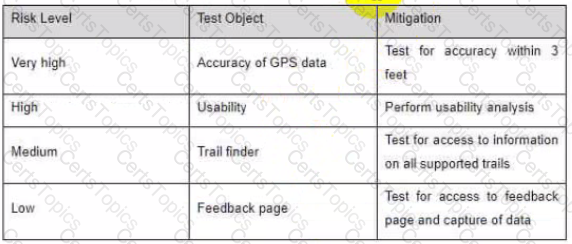Your team has been assigned to lest a new product thatis tightly integrated with existing systems The integrations include data transfers and transformations You have access to the architectural design documents and the integration specifications and some of your testers are former developers.
Given this information, what is the most appropriate test approach?
What is the purpose of the defect management committee?
You are looking to Improve the efficiency of testing. The developers have been claiming that the majority of defect reports they receive are invalid either due to the test environment or becausethe tester did not follow the right steps In a standard defect management process where should you look for more information about these invalid defects?
Your team has been assigned to a new project You have a mix of manual testers and automation engineers but everyone is currently doing manual testing.The development learn has already decided to use DevOps as its approach but they have never used it before and are happy to take your input Unfortunately, about 50% of the development is completed already In the testing your team is doing they are finding that about 40% of the defects they catch are actually regressions caused by other changes
Given this information what should you do to help mitigate risk'?
Your manager has decided thatyour team of manual testers should all become test automation engineers Your team is much stronger in analysis than In technical testing so youare concerned about their abilityto adapt.What tool capabilities could help with this transition?
You are working on a project that is having problems with regressions. Witheach release of software given to the test team. 50% of the defects found are actually regressions.To combat this you have decided to implement test automation.You have given your automation team the following goal
'Implement lest automation to automate 90% of the manual regression tests before the productrelease date.’’
Which of the following is likely an issue with this goal being defined as "SMART?
You feel that your team has become lazy when applying good software testing techniques You have given each of them a challenge to take a different business rule and build a full decision table and then collapse that table You will then assess the results For this assessment, whatcompetencies are you validating?
In what environment are you mostlikely to see multiple defect management systems used in one project?
You tend to be conservative in your project estimations because you know how many things can go wrong and extend the schedule. You manager is not happy with your estimates and thinks you are being too negative with your numbers and not trying hard enough Which estimation method should you use to provide your manager with a positive' number while still also providing the number you think is more realistic?
Which of the Mowing Is commonly used by a test manager to identity risks'
What occurs In the retrospective closing?
In an Agile project, when Is it acceptable lo not write a formal defect report when a defect is found''
Which of the following is required to apply an experience-based testing approach''
You are managing the test team that is testing a new mobile application that provides a "step-by-step' hiking guide Your risk assessment resulted in the following table:

Your team has clone the depth and breadth testing for the GPS accuracy and usability features but when the product was given to beta testers there were some issues Despite the users reporting the app was easy to use at least one user walked off the edge of a cliffand another one ended up in a river.Your team has confirmed that the functionality is working correctly. and the GPS information is accurate.
What other area of testing should you now prioritize?
Which of the following Is a way in which risk analysis drives testanalysis?